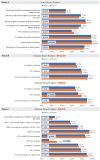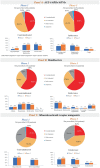BLITZ-HF: a nationwide initiative to evaluate and improve adherence to acute and chronic heart failure guidelines
- PMID: 35785461
- PMCID: PMC10084144
- DOI: 10.1002/ejhf.2605
BLITZ-HF: a nationwide initiative to evaluate and improve adherence to acute and chronic heart failure guidelines
Abstract
Aims: To assess adherence to guideline recommendations among a large network of Italian cardiology sites in the management of acute and chronic heart failure (HF) and to evaluate if an ad-hoc educational intervention can improve their performance on several pharmacological and non-pharmacological indicators.
Methods and results: BLITZ-HF was a cross-sectional study based on a web-based recording system with pop-up reminders on guideline recommendations used during two 3-month enrolment periods carried out 3 months apart (Phase 1 and 3), interspersed by face-to-face macro-regional benchmark analyses and educational meetings (Phase 2). Overall, 7218 patients with acute and chronic HF were enrolled at 106 cardiology sites. During the enrolment phases, 3920 and 3298 patients were included, respectively, 84% with chronic HF and 16% with acute HF in Phase 1, and 74% with chronic HF and 26% with acute HF in Phase 3. At baseline, adherence to guideline recommendations was already overall high for most indicators. Among acute HF patients, an improvement was obtained in three out of eight indicators, with a significant rise in echocardiographic evaluation. Among chronic HF patients with HF and preserved or mid-range ejection fraction, performance increased in two out of three indicators: creatinine and echocardiographic evaluations. An overall performance improvement was observed in six out of nine indicators in ambulatory HF with reduced ejection fraction patients with a significant increase in angiotensin receptor-neprilysin inhibitor prescription rates.
Conclusions: Within a context of an already elevated level of adherence to HF guideline recommendations, a structured multifaceted educational intervention could be useful to improve performance on specific indicators. Extending this approach to other non-cardiology healthcare professionals, who usually manage patients with HF, should be considered.
Keywords: Acute heart failure; Adherence; Chronic heart failure; Guidelines; Registry.
© 2022 The Authors. European Journal of Heart Failure published by John Wiley & Sons Ltd on behalf of European Society of Cardiology.
Conflict of interest statement
none declared.
Figures



Comment in
-
Implementing the evidence - the true summit of evidence-based care and the false peak of guidelines.Eur J Heart Fail. 2022 Nov;24(11):2090-2092. doi: 10.1002/ejhf.2712. Epub 2022 Oct 17. Eur J Heart Fail. 2022. PMID: 36194559 No abstract available.
References
-
- Nieminen MS, Brutsaert D, Dickstein K, Drexler H, Follath F, Harjola VP, et al.; EuroHeart Survey Investigators; Heart Failure Association, European Society of Cardiology . EuroHeart Failure Survey II (EHFS II): a survey on hospitalized acute heart failure patients: description of population. Eur Heart J. 2006;27:2725–36. - PubMed
-
- Tavazzi L, Senni M, Metra M, Gorini M, Cacciatore G, Chinaglia A, et al.; IN‐HF (Italian Network on Heart Failure) Outcome Investigators . Di Lenarda A, Mortara A, Oliva F, Maggioni AP; Multicenter prospective observational study on acute and chronic heart failure: one‐year follow‐up results of IN‐HF (Italian Network on Heart Failure) outcome registry. Circ Heart Fail. 2013;6:473–81. - PubMed
-
- Maggioni AP, Anker SD, Dahlström U, Filippatos G, Ponikowski P, Zannad F, et al.; Heart Failure Association of the ESC . Are hospitalized or ambulatory patients with heart failure treated in accordance with European Society of Cardiology guidelines? Evidence from 12,440 patients of the ESC Heart Failure Long‐Term Registry. Eur J Heart Fail. 2013;15:1173–84. - PubMed
-
- Allen LA, Fonarow GC, Liang L, Schulte PJ, Masoudi FA, Rumsfeld JS, et al.; American Heart Association's Get With The Guidelines Heart Failure (GWTG‐HF) Investigators. Medication initiation burden required to comply with heart failure guideline recommendations and hospital quality measures. Circulation. 2015;132:1347–53. - PMC - PubMed
-
- Ponikowski P, Voors AA, Anker SD, Bueno H, Cleland JG, Coats AJ, et al. 2016 ESC Guidelines for the diagnosis and treatment of acute and chronic heart failure: The Task Force for the diagnosis and treatment of acute and chronic heart failure of the European Society of Cardiology (ESC). Developed with the special contribution of the Heart Failure Association (HFA) of the ESC. Eur J Heart Fail. 2016;18:891–975. - PubMed
Publication types
MeSH terms
LinkOut - more resources
Full Text Sources
Medical
Research Materials
Miscellaneous

